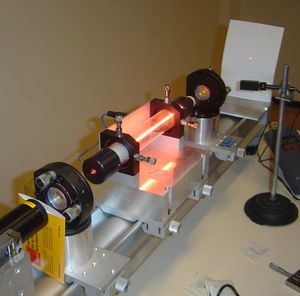Helium
| Helium | |
|---|---|
| He | |
| In situ availability: | trace |
| Necessity: | |
| Atomic number: | 2 |
| Atomic mass: | 4.002602 |
| group: | 18 |
| period: | 1 |
| normal phase: | Gas |
| series: | Noble gases |
| density: | 0.1786 g/L |
| melting point: | 0.95K, -272.2°C, -458.0°F |
| boiling point: | 4.22K, -268.93°C, -452.07°F |
| N/A ← N/A → N/A | |
| H ← He → Li | |
| F ← Ne → N/A | |
| Atomic radius (pm): | 31 pm |
| Bohr radius (pm): | |
| Covalent radius (pm): | 32 |
| Van der Waals radius (pm): | 140 |
| ionic radius (pm): | - |
| 1st ion potential (eV): | 24.59 |
| Electron Configuration | |
| 1s2 | |
| Electrons Per Shell | |
| 2 | |
| Electronegativity: | |
| Electron Affinity: | Unstable anion |
| Oxidation states: | - |
| Magnetism: | |
| Crystal structure: | Hexagonal or body centered cubic |
Helium is a component of the solar wind, and hence is one of the volatiles found (in parts per million level) in Lunar regolith. It is a Noble gas in group 18 and is the second element in the Periodic Table of the Elements. This element has two stable isotopes: 3 and 4.
The most common isotope, Helium-4, has a nucleus of two protons and two neutrons, and two electrons. The less common isotope Helium-3 has two protons and one neutron.
Contents
3He
Helium 3 is a rare isotope of the element Helium, consisting of a nucleus with two protons and one neutron. The approved abbreviation (for physics use) for Helium-3 is 3He, however, the abbreviation He3 is also seen. Since most of the Earth's helium is produced by alpha-decay of Uranium isotopes, resulting in 4He (the most common isotope of Helium), 3He is rare on Earth. It is comparatively more abundant in non-terrestrial sources, although even in non-terrestrial sources, only a small fraction of helium atoms are Helium 3. The Moon is a source of 3He, which is implanted into the lunar regolith by the solar wind. Helium is present in the soil in quantities of ten to a hundred (weight) parts per million, and 0.003 to 1 percent of this amount (depending on soil) is 3He.
Helium 3 as a Fusion Reaction Fuel
It has been proposed that 3He might be a possible fuel for a Nuclear Fusion reactor to produce energy using the nuclear reaction:
2D + 3He --> 4He + 1H
This reaction has the advantage over the more-commonly proposed D-T fusion reaction that the reaction produces only charged particles (an alpha particle and a proton), with no production of neutrons. However, the corresponding difficulty is that the D-3He reaction has an ignition barrier that is twice as high as the barrier to igniting D-T fusion, because of the fact that the Helium nucleus has twice the charge of a Tritium nucleus. Gerald Kulcinski's group at the Fusion Technology Institute of the University of Wisconsin-Madison has operated an experimental He3 fusion reactor for an extended period, on a non-governmental research budget [1], however the reactor has not achieved energy balance or breakeven. So far, D-3He fusion has not yet demonstrated net energy production ("break even"). The development of commercial He3 reactors is dependent upon demonstrating "break even."
FIELD_MESSAGE_chielclaolo
Applications
- Medical Lung Imaging
- According to Wikipedia:
- http://en.wikipedia.org/wiki/Helium_3
- Details on this experimental application of He3: http://cerncourier.com/main/article/41/8/14
| This section of the article is incomplete or needs more detail. You can help Lunarpedia by expanding or correcting it. |
Links
External Links
References
| Work on this article has outpaced copyediting on it. You can help Lunarpedia by formatting, editing, or tidying it. |







